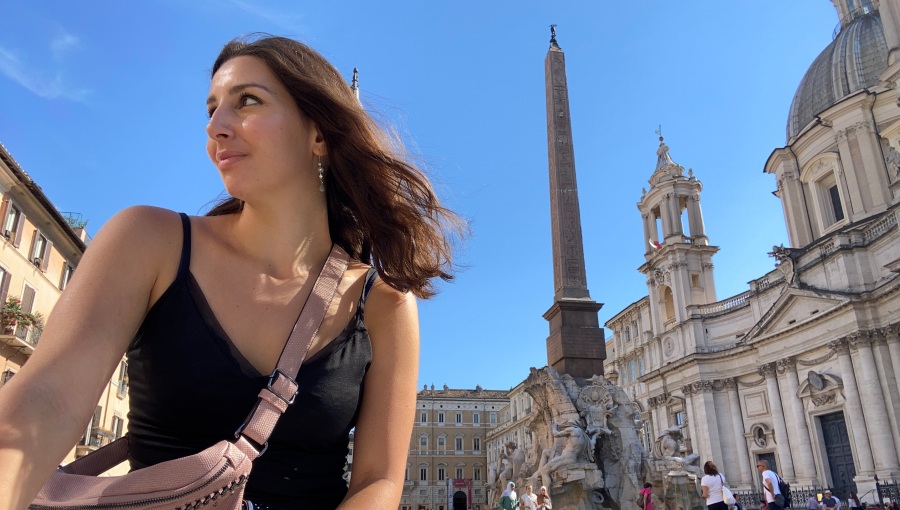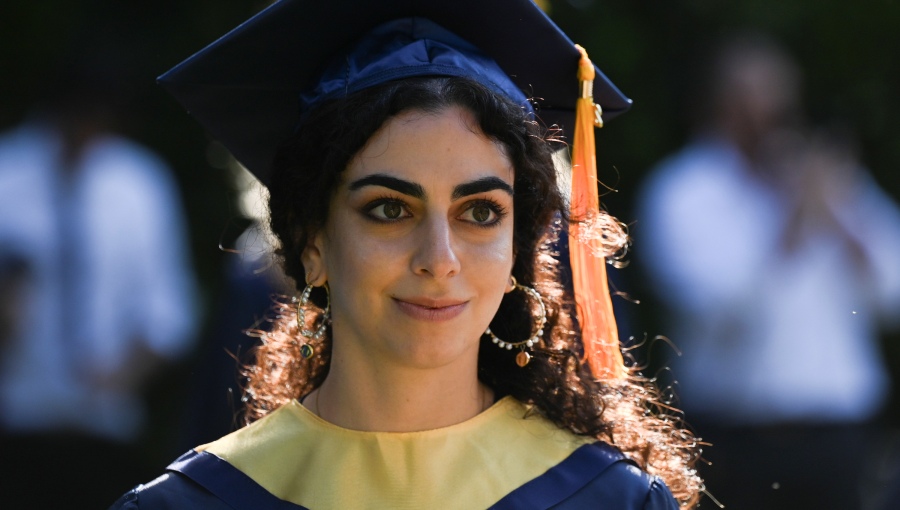Futurist Food: Meet M.A. Student Lea Ramaswamy
Hailing from Pune, India, Lea Ramaswamy is currently pursuing an M.A. in Art History at JCU after graduating from the University with a B.A. in Art History in 2021. Lea is writing her M.A. thesis on Futurist Food, and is currently doing an internship at the Museo delle Civiltà (Museum of Civilizations) in Rome.

Lea Ramaswamy
What brought you to JCU?
I found myself in Rome on a family vacation in 2016, while I was still in high school. I was very much in the process of finding my way. I had a lot of passions, most of them half-baked. I had recently discovered a love for history, and my mother made a throw-away comment during a dinner in Trastevere about how funny it would be if I were to come to Rome to study Art History. When college applications rolled around, my mother stumbled upon an advertisement for John Cabot University, located – as she informed me, excitedly – in the very neighborhood where she had her vision.
You graduated from JCU with a B.A. in Art History in 2021. What made you decide to enroll in JCU’s M.A. in Art History?
It took me some time to adjust to Rome. I felt, as an Indian student, that I did not have the same experience as many of my American and European colleagues – both in terms of immigration procedures and the fact that I was never granted the benefits that come with being seen as an expat as opposed to an immigrant, outside the comfortable (and safe) walls of JCU. Once I felt that I had settled and grown roots in the “real” Rome, I became more involved. I joined the Art History Society, and it was here that I found productive ways to channel my frustration with adapting to life in Italy as a person of color. The Art History Department representative of that year, Elena Schembri, spear-headed a series of town hall meetings that addressed the Euro-centric content of many of the Art History courses, and to our collective, and elated surprise, the discourse led to the introduction of four non-Western courses in Fall 2020. I stayed because I saw clearly, at that moment, the commitment of the Art History faculty to respond to what their students need and update the curriculum to fit the latest, critical standards. I don’t think you would get that in a lot of bigger universities. I was not ready to leave this.
You are writing your M.A. thesis on Futurist Food. Tell us about this topic.
In addition to being an Art Historian, I am a cook. I have found that most Art History professors at JCU are extremely enthusiastic to help students find research that fits into their niche, and for me, that has always meant mixing art history and food. For example, during my B.A., I wrote a paper on De Re Coquinaria, an ancient Roman cookbook, for a class on Latin Literature with Professor Massimo Betello. In the M.A., I wrote a paper for Professor Inge Hansen’s class on Ancient Roman Public and Private Spaces on slave agency and movement during banquets; for Professor Carolyn Smyth’s Dark Renaissance seminar I produced an essay about the legacy of medieval herbalism in early modern botanical illustration; and finally, I wrote about the Manifesto of Futurist Cuisine (1930) by Italian theorist Filippo Tommaso Marinetti for Professor Sarah Linford‘s class on Italian 20th-century art, and which I then decided to expand upon for my thesis. The subject is complicated and confronts the “delicate” relationship between Italian national identity, food, and fascism. Due to the fact that Futurism is configured in Italy as the country’s most important contribution to modern art, its political dimension is suppressed or undermined. My work finds that Futurist food, which is incredibly understudied, addresses two blind spots in the field. The first is that it embodies a particular strain of Avant Garde that is enthusiastically functioning at the service of fascist politics, satisfied with its long-desired role as part of the fascist institution. Second, by finding its medium in food, an art form that arguably only gains mainstream recognition in the canon by the time of Arte Povera, it is ignored in lieu of Futurism’s more traditional forms of painting, sculpture, or even design (fashion, interiors).
What does your internship at the Museo delle Civiltà entail? What’s your favorite aspect of the internship?
Working at the Museo delle Civiltà (Museum of Civilizations) has been one of the most surprising and exciting experiences I have had in Rome. Located in the neighborhood of EUR and built for the 1942 Universal Exposition of Rome under the fascist regime, the museum is a highly contested and problematic space. Its collections are derived from multiple Italian ethnographic and colonial collections that have not been contextualized until recently, with the museum’s new director, Andrea Villiani. During an incredibly tense moment in Italian politics, working at the museum has been eye-opening, a window into the dense network of bureaucracy that is inherent to a national institution of its variety.
What are your plans for the future?
I will continue working at the Museum now that my internship is complete. I have also recently been given the position of Assistant Curator for Rome’s Spazio Griot, and I am continuing to work on a series called “Diaspora Dinner Experiences” with an incredible creative collective, Melanin Flavors, run by JCU alumna, Stella Militello-Belgrave.





